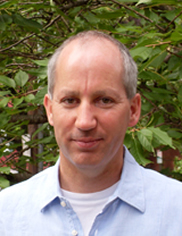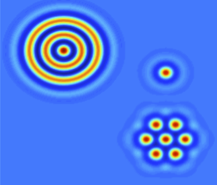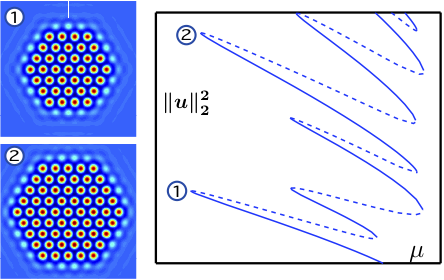The
Crawford prize is dedicated to the memory of J. D. Crawford and awarded biannually since 2001 at the `Snowbird' conferences to one individual for recent outstanding work on a topic in nonlinear science.
In a planned series of articles the winners are invited write about their mathematical biography, their work, and what they consider important problems in the field of applied dynamical system. This article contains the contribution of the first prize winner Björn Sandstede (Brown).
The members of the 2001 Crawford prize committee were Christopher K. R. T. Jones (Chair), James Keener, Edgar Knobloch, Robert McKay, and Harry Swinney.
Björn Sandstede was awarded the prize "For his fundamental contributions to the study of spiral waves: based on deep work on the stability of nonlinear waves and symmetry-breaking bifurcations in systems with Euclidean symmetry."
|

Picture from http://www.dam.brown.edu/people/
|
My interest in mathematics developed primarily during high school, thanks to my math teacher Willy Kurz, who did a tremendous job teaching us calculus. (Seemingly without any effort, he got us to appreciate proofs, and did so in a very inspiring way.) My undergraduate and graduate studies, under the supervision of Bernold Fiedler, were done in Heidelberg and Stuttgart. After my PhD, I moved to the Weierstrass Institute in Berlin, where I was a postdoc from 1993 to 1997. During this time, I also spent 15 exciting months with Chris Jones’s group at Brown University, where I learned about stability and nonlinear optics. In 1997, I moved to The Ohio State University as an assistant professor (and, yes, I still watch the Buckeyes whenever I can!), where I was granted tenure in 2000 and promoted to full professor in 2004. Being in a large department such as Ohio State’s math department is sometimes challenging (it took me over a year to know all my colleagues by name) but also offers many opportunities: getting a VIGRE grant helped us in many ways, and another transforming and exciting change occurred when the NSF awarded Ohio State the Mathematical Biosciences Institute (MBI), which was established in 2002. In 2004, I moved to the University of Surrey in Guildford, England. The maths department there focuses on nonlinear mathematics and its applications: I highly value my time there, working in a very friendly and collegial yet ambitious and vibrant environment. In 2008, I returned to Providence, where I am with the Division of Applied Mathematics at Brown University. It is a terrific place: I very much enjoy teaching here (the undergraduates are simply amazing) and working with graduate students and postdocs ... which brings me to my research interests.


Much of my recent work is related to localized planar structures such as radial spots and patches of hexagons or stripes. When continued in systems parameters, the associated solution branches snake as illustrated in the accompanying figure: infinitely many stable patterns coexist at the same parameter values, and these structures all lie on the same solution branch and differ by their spatial width. Snaking in 1D is well understood, but the planar case is much more complicated to analyse and remains open. With Daniele Avitabile (Bristol), David Lloyd (Surrey), Peter van Heijster (Brown) and Scott McCalla (Brown), I currently work on the existence and snaking behaviour of planar spots and oscillons using a mixture of analytical and numerical approaches. My second interest is in nonlinear stability of coherent structures. My main goal is to establish a stability theory for sources such as 1D and 2D spiral waves. These structures can be thought of as localized defects that create wave trains that move away from the localized core that generates them. The presence of the asymptotic wave trains makes the stability problem nontrivial: sources are time-periodic in a comoving frame, and the asymptotic wave trains generate essential spectrum that touches the unit circle. In work with Margaret Beck (Boston), Hermen Jan Hupkes (Brown) and Kevin Zumbrun (Indiana), we have established nonlinear stability results for time-periodic Lax shocks in continuous and semidiscrete viscous conservation laws, and our goal now is to adapt these techniques to the case of sources in reaction-diffusion systems. Another area I am interested in is travelling waves in lattice dynamical systems. Hermen Jan Hupkes and I are working on the existence and stability of fast pulses for the discrete FitzHugh-Nagumo equation, and we plan to use our techniques (such as versions of the Exchange Lemma that work for ill-posed functional differential equations) in other contexts.
I was asked to write a paragraph about what I view as the important problems in applied dynamical systems. This is a very broad field, and it is difficult for me to single out specific topics as being of particular importance. The major challenge for me personally is to find the right balance between working on relevant applications and on general theoretical questions. It is tempting to focus on what one does best (or thinks one does best) without using the freedom we have in our academic environment to branch out and seek interdisciplinary collaborations or learn more about complementary techniques and approaches. In particular, the main challenges and opportunities I see for myself in the future are to connect in more meaningful ways to applications arising, for instance, in biology or in energy initiatives. To answer the original question in the narrower area of pattern formation that I work in, one of the central open theoretical problems is to develop methods for planar patterns with no prescribed symmetries, such as quasiperiodic structures or localized patterned patches: not much is known rigorously or formally about such structures, and any progress in this direction would be very relevant and useful.